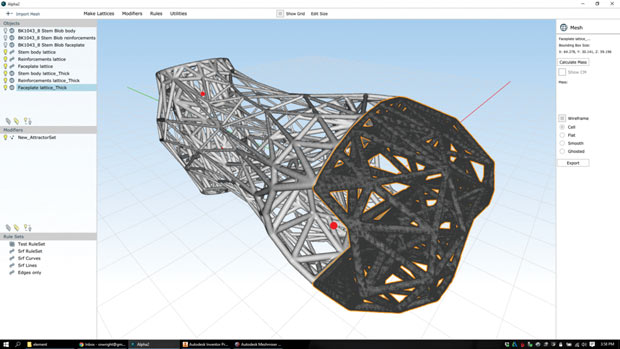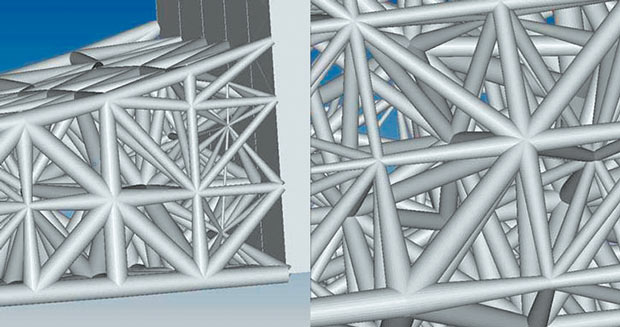
nTopology Element. Image courtesy of nTopology.
Latest News
May 2, 2016
 Among the various methods for finding the optimal structure of a product or component, topology optimization is one that software vendors today are working to make more accessible and easier to use by engineers and designers. A key driver of these efforts is the surge of activity around additive manufacturing (AM). In marked contrast to the over-hyped but currently under-performing category of consumer 3D printers, AM is garnering high interest from manufacturing industries today because of advances in materials and processes that make it an increasingly practical method for manufacturing actual production parts and assemblies.
Among the various methods for finding the optimal structure of a product or component, topology optimization is one that software vendors today are working to make more accessible and easier to use by engineers and designers. A key driver of these efforts is the surge of activity around additive manufacturing (AM). In marked contrast to the over-hyped but currently under-performing category of consumer 3D printers, AM is garnering high interest from manufacturing industries today because of advances in materials and processes that make it an increasingly practical method for manufacturing actual production parts and assemblies.
One of AM’s prime attractions for engineers is how it enables design and production of objects with new levels of geometric complexity. These geometries can deliver functionality that’s either impossible or not feasible to achieve with conventional manufacturing methods. In particular, AM is ideally suited to creating lightweight designs, often using fewer parts than a comparably functioning design produced with subtractive manufacturing.
Topology optimization is a design method that tends to yield biomorphic-like shapes ideally suited to production using AM. Indeed, they often cannot be produced by conventional subtractive manufacturing without modifications that would substantially dilute the optimal balance of light weight vs. high strength achieved in the optimization process.
Topology optimization software generates a conceptual 3D structural design that best meets the design requirements specified by the user. It does this by optimizing material layout within a given physical design volume for a specified set of loads and boundary conditions, so that the resulting layout meets the prescribed performance targets.
nTopology Element Built for Additive Manufacturing
An intriguing new market entrant is nTopology, Inc., which describes its nTopology Element software as “purpose-built to harness the power of additive manufacturing.” The software offers a combination of generative, manual and simulation-based design tools to let engineers create parts whose functional requirements are “baked right in,” as the company puts it. Element lets users optimize lattice structures with respect to user-defined inputs, imported data or the software’s integrated finite element analysis (FEA) capabilities.
Element’s workflow and structural analysis engine are designed to help users exploit the strengths of AM. Instead of a traditional feature tree, nTopology organizes elements into Objects, Modifiers and Rule sets. Objects are imported or created from scratch. Lattices are created using Rule Sets, and those lattices are thickened using Modifiers that can be generated either explicitly or based on built-in FEA simulation data. By integrating simulation data into the design process early, nTopology Element is intended to help designers create structures for specific functional outcomes. Then, by recombining elements, users can iteratively tune those structures to improve mechanical performance and reduce cost.
ESI Group Targets AM Design Challenges, Process Optimization
ESI Group is another of the growing number of software vendors developing tools to address additive manufacturing design challenges and process optimization. It has developed advanced topology optimization tools that take account of functional constraints—for example, minimizing weight while bearing a given functional load—and at the same time addressing manufacturing constraints such as minimum wall thickness.
At the same time, ESI’s manufacturing process simulation tools are being used in the DARPA Open Manufacturing (OM) initiative to develop what DARPA terms Integrated Computational Materials Engineering (ICME) tools and methodologies to support the application of AM technologies in the aerospace industry. For example, in the AM method known as direct metal laser sintering (DMLS), a laser aims at a succession of points in space defined by a 3D model, firing into a bed of powdered metal and thus welding the metal particles together to create a solid structure in the shape of the 3D model. ESI’s software for simulating multi-scale, multiphysics phenomenon has been used to model and optimize the DMLS manufacturing process.
Altair Debuts New AM Capabilities
Yet another notable vendor focused on topology optimization for additive manufacturing is Altair, whose recently announced OptiStruct 14.0 includes a new solution for design and optimization of lattice structures to support AM. Leading the way in giving users fine-grained control over topological details, OptiStruct 14.0 enables design of lattice structures consisting of tapered beams, for example, and supports smoothing and re-meshing throughout lattice optimization.
Meanwhile, Altair’s subsidiary solidThinking just released solidThinking Inspire 2016, its generative design software targeted at helping design engineers, product designers and architects investigate structurally efficient concepts quickly and easily. One key advance is a new PolyNURBS tool and related aids that let users quickly and easily flow optimized designs into manufacturable products by wrapping topology results with NURBS geometry. Before, users had to import optimization results from Inspire into their CAD system to generate manufacturable geometry. Now, the new NURBS tools let users create solid organic geometry in Inspire more quickly than in CAD, then bring that near-production-ready geometry into CAD to add final details needed for production.
More Info
Subscribe to our FREE magazine, FREE email newsletters or both!
Latest News
About the Author
Bruce Jenkins is president of Ora Research (oraresearch.com), a research and advisory services firm focused on technology business strategy for 21st-century engineering practice.
Follow DE







